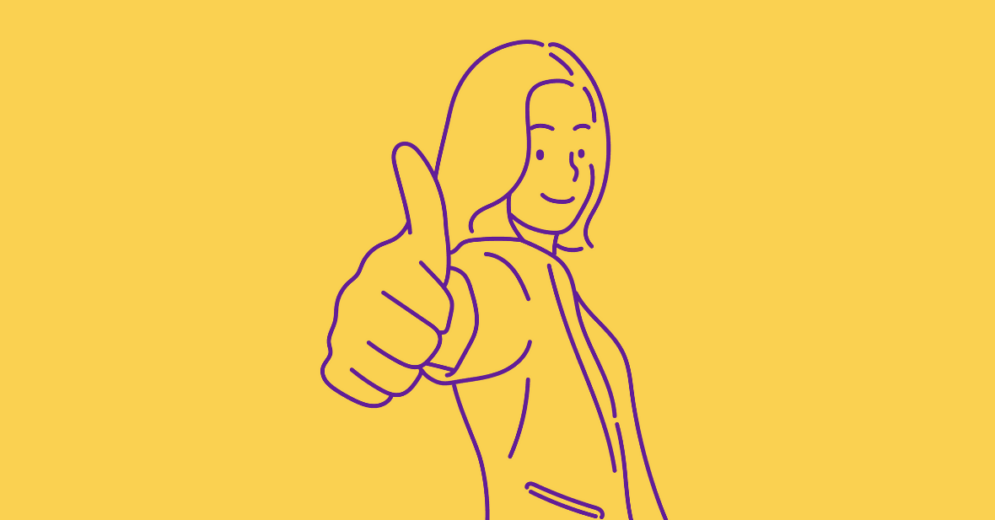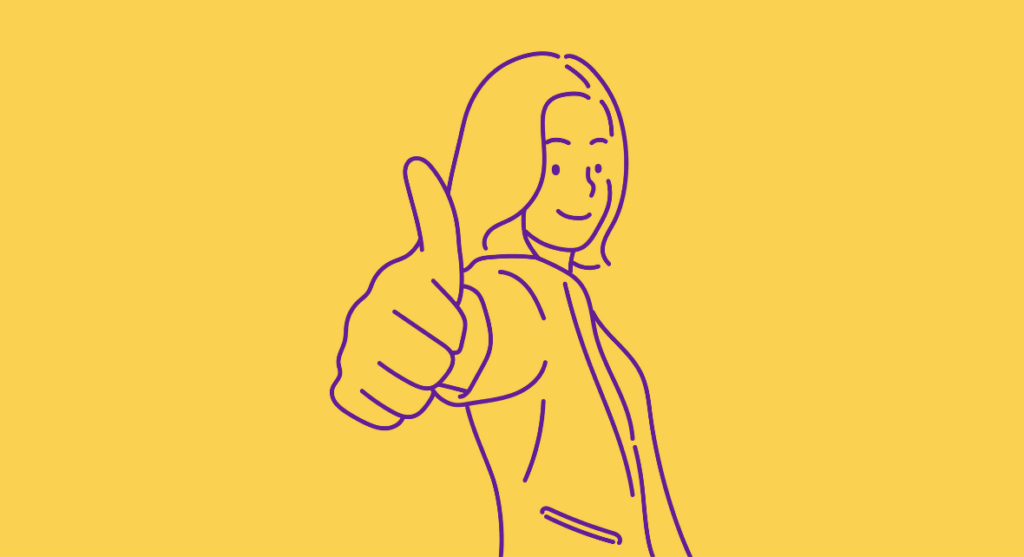In the past, work was often seen as simply a means to make money and synonymous with stability.
However, this perception of work has changed dramatically over time.
Nowadays, people look for jobs that provide financial stability and bring them satisfaction, quality of life, and new possibilities.
This might be the reason why the field of UX Design is booming. This is not just because of the great salary that comes with it but also for many other reasons, like flexibility and the satisfaction of impacting the lives of others through design.
With that said, let’s explore the reasons behind the growth of UX Design, what this profession entails, and why we firmly believe it’s an amazing career path.
Reading tip: How I Switched from Biology to UX Design – Interview with Lívia Assunção
The Boom of UX Design
A study by NN/g (Nielsen Norman Group) shows that the field of UX Design has been growing exponentially over the past few years and the trend is expected to continue to grow even more until 2050.

Several factors are responsible for this growth, including:
- Technology and Innovation: technology is increasingly focused on consumer comfort, considering the growth of IoT – Internet of Things;
- User-Centered Design: the concept of User Centered Design is increasingly widespread in the market;
- Companies hiring more Product Designers: companies increasingly understand the importance of user focus and how it is a fundamental strategy for their development;
- Increased investment by companies in UX: companies hire more and, consequently, invest more in UX Design.
Given this scenario, it’s easy to see why so many people are transitioning to UX Design. It may be time for you to consider making the same move.
Reading tip: UX Design In High Demand
What is UX Design?
UX Design is the area responsible for developing the human side of technology. The Product Designer is the one who will work to ensure that the consumer has the best possible interaction experience with a particular product or service.
Thus, the main focus of UX Design is the user, not the product. All work developed by UX is to ensure that the user has the best experience, bringing some advantages such as:
- customer loyalty;
- better user experience with the company and product;
- efficiency in production;
- increased revenue for the company;
- improvement of the company’s image.
Therefore, UX Design is a profession that requires a lot of research, testing, and empathy for users. That’s why no machine can replace the work of a UX professional.
That being said, let’s check out 10 reasons that make UX Design an incredible profession!
Reading tip: The Multidisciplinary World of UX Design
1) UX Design is dynamic

Unlike professions with more apathetic routines, UX Design will never leave you idle. This is because a UX/Product Designer will always have some new project or challenge to work on.
In this sense, there are always new research and studies, new tests, and new problems to solve. Each UX project is made for a different client with different objectives.
Therefore, for each one of them, you will have to search for creative solutions, create new processes, look for new tools, perform usability tests and research, and deal with different people all the time.
In other words, there will always be something new to deal with and to learn in UX Design!
Reading tip: How to Pivot Into a UX Design Career: 10 Initial Steps
2) UX Design is a strategic area
One of the main differences between Graphic Design and UX Design is precisely the balance between operational and strategic activities.
We can say that the UX Designer role is much more strategic, where you will spend more time thinking and researching than getting hands-on.
Thus, being in a more strategic position allows you to improve your business vision of the company and its clients.
“The biggest difference for me is that UX is a more strategic area. While the Graphic Designer deals with a more creative and imaginative part, UX is more based on research, facts, data, and people. It’s not enough to have an idea if it doesn’t work. It’s no use creating a beautiful website if it’s not functional for the audience.” – Joyce Almazan, MID student
3) You don’t need a background in design
Unlike other professions, UX Design does not require a background in Design or any related area.
In fact, according to a study by InVision, recruiters find it important for Product Designers to have experiences in areas outside of design.

A professional with a diverse background can offer multiple perspectives to solve problems.
Check out the interviews with our MID students to see the stories of people who switched to UX Design from various fields such as psychology, administration, graphic design, etc.
Reading tip: Student Testimonials: What Do They Say About MID Program?
4) Good salaries
According to InVision’s research, UX Designers’ salaries are the highest compared to other design positions within a company.
However, Product Designers’ salaries have increased in the last 2 years, and the trend is for them to increase even more in the coming periods.

The average salary is also high for UX Designers, according to the website Glassdoor.

5) Satisfaction in helping people
We’ve already seen that the main goal of UX Design is to improve the user’s experience, but what does that mean exactly?
Improving the consumer’s interaction with a product or application also means improving their quality of life.
Therefore, working with UX Design involves stopping to listen to the user’s needs and problems and researching the best solution to address those difficulties. Unlike other professions that work for themselves, the Product Designer works to help other people.
“With UX/UI, I can really make a difference in someone’s life. And always for the better. Meeting a pain point or a need. Knowing what that person needs and being able to deliver the best to them.” – Diogo Alvarez, MID student.
6) Teamwork and collaboration between departments

As a strategic and business-oriented field, the UX Designer interacts with various areas within the company. With other designers, researchers, and developers, and reaching the board of directors.
Thus, due to this interaction, the Product Designer is constantly learning. Therefore, it is an ideal profession to improve both hard and soft skills.
Additionally, teamwork is also a strong point in this profession. The UX Designer does not work alone; close interaction is important to provide space for new ideas and creativity in problem-solving.
“The difference that impressed me the most was truly working like a team. The experience I had was everyone working on their own, with autonomy, a conversation when delivering the product, and that was it. Here, everyone works together all the time, exchanging ideas and knowledge with the rest of the team. That was what changed the most in my day-to-day life.” – Luka Vasconcelos, MID student.
7) Always being aware of the latest trends
Product Designers work in various areas, such as research, development, creativity, and even psychology. This means they are always up-to-date with market trends and news.
UX Designers are constantly looking out for new tools and software that can aid in the development process.
If you are someone who loves staying up-to-date with everything that happens in your field, then UX Design is the perfect choice for you.
Reading tip: UX Design: What Are the Possibilities for Working in the Field?
8) Active community

Once you start working with UX Design, you automatically enter a community of professionals who always seek to help each other.
It is very common in the UX industry to mentor a colleague and vice versa. This way, a strong sense of community is created among Product Designers, which also guarantees good learning and networking.
The same thing happens in the Mastering Interface Design program. Our community of students is always active, helping each other with exercises, doubts, opportunities, etc.
In addition, the course’s teachers and mentors are also part of the community, adding even more knowledge and experience to the discussions.
Reading tip: UX Design Portfolio: 6 Essential Tips for Building Yours
9) The dissatisfaction is not about the job
NN/g conducted a career satisfaction survey that showed that over 81% of Product Designers interviewed are happy with their careers, many for the reasons we have already mentioned.
However, 8% who responded as being dissatisfied with their career showed an interesting reason for it.
Their dissatisfaction was with their current job position and not with their career as a whole.
The respondents stated that they were not happy because:
- they were not learning enough about UX;
- they were not using their UX skills as much as they would like;
- they wanted to change companies, not careers;
- they did not see a clear path for their career in their current company.

Therefore, working with UX Design can indeed bring challenges, but they are not necessarily related to the profession itself.
10) Great chances of an international career
We have already observed that the UX Design industry is growing, so there are great opportunities to work in international companies.
However, despite this, it is not necessary to live abroad to get an international opportunity. Many companies accept remote professionals for their projects.
That means you can continue working physically from where you are but serve clients from another country.
MID students who work in international companies
Many students of our UX and Product Design Certification Program have already landed jobs in international companies, either by moving to another country or by working remotely.
Check out some examples below:
- Israel Mesquita: lives and works as a UX/UI Designer in Austria;
- Leonardo Spolador: lives in Brazil but has worked remotely for an American company as a UX Designer;
- Inis Leahy: Inis Leahy: currently lives in Dublin and works as a Product Designer at Udemy. Know more of her story in her interview;
- Daniel Hidelbrandt: lives and works as a Product Designer at a company in Canada. Check out his interview;
- Rodrigo Medeiros: lives and works as a Product Designer in Portugal. Check out his interview.
Reading tip: LinkedIn for Designers: Tips to Boost Your Profile
Quick tips for transitioning to UX Design
If you liked the reasons listed above and want to start your process to transition to UX Design, check out some quick tips that can help you:
- Update your portfolio and LinkedIn: these resources are extremely important for making a career transition. Your portfolio will showcase your work and problem-solving skills, while LinkedIn is a great networking tool that can help you find opportunities;
- Don’t be afraid: take more risks. We know how hard it is to start from scratch in a new career, but that should not limit your search for your dream career;
- Keep learning: seek courses, books, videos, and other relevant content that can add knowledge. The important thing is to learn as much as possible to facilitate the career transition.
Aela offers several tips and articles about design, business, and careers. Subscribe to our newsletter to stay in the loop!








